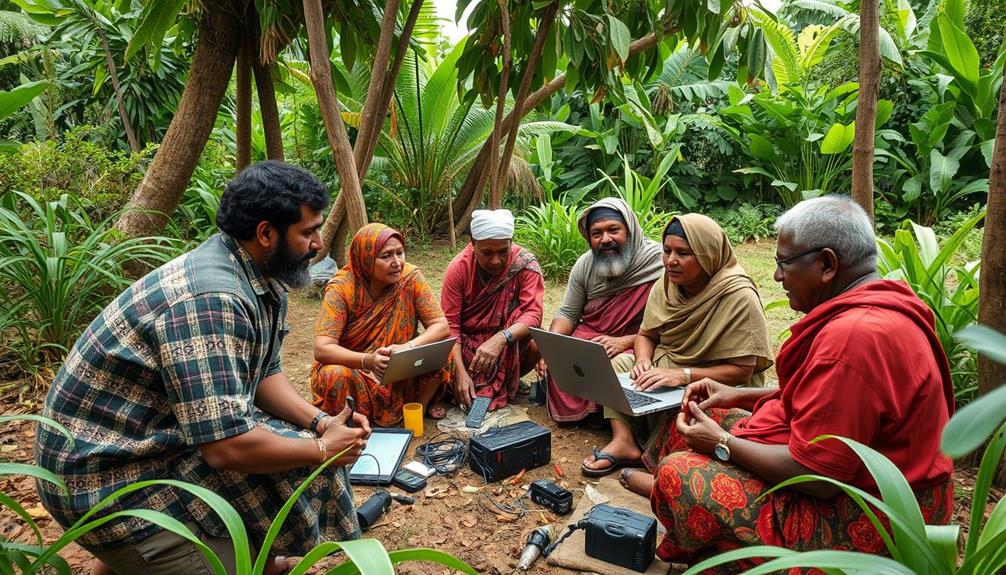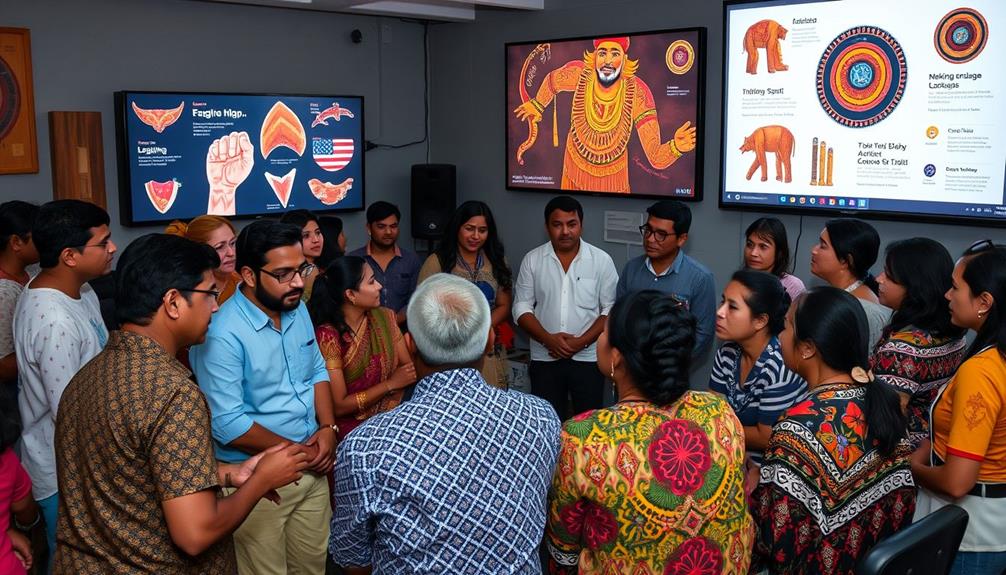AI plays an essential role in preserving endangered languages and cultures by using advanced technologies like Natural Language Processing and machine learning. You can see how these tools assist in documenting unique languages and archiving oral traditions for future generations. Collaborative projects, such as Google's Endangered Languages Project, help communities share their linguistic heritage. Innovative solutions, including interactive platforms, engage younger audiences in learning languages. By involving local communities, AI guarantees that language preservation reflects authentic cultural identities. If you explore further, you'll discover even more impactful examples and insights into this transformative movement.
Key Takeaways
- AI technologies, such as Natural Language Processing and machine learning, assist in documenting and analyzing endangered languages to support preservation efforts.
- Community engagement with AI tools, like interactive robots and mobile apps, fosters language learning and cultural connection among younger generations.
- Ethical considerations in AI usage ensure that the values and beliefs of language-speaking communities are accurately represented and protected.
- Collaborative projects, such as Google's Endangered Languages Project, enhance accessibility and resources for documenting endangered languages globally.
- AI-powered solutions can integrate language preservation into educational programs, raising awareness about the importance of linguistic diversity.
Understanding Language Endangerment
Language endangerment is a pressing issue affecting over 40% of the world's roughly 7,000 languages, with a minority language disappearing every two weeks. This alarming trend puts immense pressure on language preservation efforts, as you witness unique cultural practices and worldviews vanish alongside these endangered languages.
The loss of a language often means the loss of cultural diversity, erasing the rich tapestries of heritage that define communities. Communities facing these challenges may also experience emotional fluctuations similar to those seen in relationships with individuals who've BPD push-pull dynamics, as their connection to language is deeply intertwined with their identity.
Globalization and the dominance of major languages exacerbate the situation, making it increasingly difficult for communities to pass down their languages to future generations. You might find that insufficient documentation and resources hinder efforts to preserve these languages, leaving many vulnerable to extinction.
This lack of support creates significant obstacles for those working to maintain their linguistic identity.
As you explore the world of endangered languages, remember that each language carries its own unique stories and traditions. Understanding the nuances of language endangerment is essential for fostering appreciation of cultural diversity and motivating action towards preserving our shared linguistic heritage.
Significance of Language Preservation

Preserving endangered languages holds immense significance for maintaining cultural heritage and identity. With over 7,000 languages spoken globally, around 40% are at risk of extinction. Each language embodies unique histories and traditions, serving as a essential record of the communities that speak them.
When you engage in language preservation, you're not just saving words; you're protecting an entire way of life. This effort is akin to the focus on wellness and health-oriented experiences in retreats, emphasizing the need for environments that support cultural and personal growth.
As highlighted in the context of retreats, transformative experiences play an important role in fostering deeper connections to heritage.
Here are some key reasons why language preservation matters:
- It maintains cultural heritage and identity.
- Each language contributes to global diversity.
- The loss of language equals a loss of cultural diversity.
- Bilingualism enhances cognitive abilities and strengthens community ties.
- International efforts, like UNESCO's declaration of 2019 as the International Year of Indigenous Languages, spotlight the urgency of action.
AI Technologies in Language Preservation

Advancements in AI technologies are transforming the landscape of endangered language preservation. With tools like Natural Language Processing (NLP), you can now understand and generate human languages, which plays a vital role in documenting and revitalizing endangered languages. These technologies make it easier for you to access linguistic resources and learn the languages at risk of disappearing.
In addition, the integration of herbalism principles, such as understanding plant properties and their uses, can serve as a metaphor for nurturing and preserving cultural knowledge and languages within communities essential knowledge for herbalism.
Machine learning algorithms analyze linguistic data, identifying patterns that support language preservation initiatives. This analysis enhances accessibility for both speakers and learners, making it easier for communities to engage with their languages.
Furthermore, speech recognition technology allows transcribing and archiving spoken languages, ensuring that invaluable oral traditions are digitally preserved for future generations.
Google's contributions to the Endangered Languages Project exemplify how AI technologies can aid in preserving linguistic diversity through collaborative efforts in language documentation.
Local community involvement, such as UC Berkeley's revitalization of the Yurok language, highlights the effectiveness of combining AI with local knowledge. By leveraging these AI technologies, you're actively participating in language revitalization and cultural preservation, ensuring that these rich linguistic heritages endure for years to come.
Innovative AI Solutions

Innovative AI solutions are reshaping how communities engage with and learn endangered languages. These technologies not only enhance preservation efforts but also make learning more interactive and accessible, aligning with the need for ethical frameworks to guide responsible AI development.
Here are some key applications:
- Opie robot: This AI-powered tool provides interactive experiences for children, teaching indigenous languages in fun ways.
- Reobot chatbot: Facilitating communication in Maori on platforms like Facebook, this chatbot makes language use more accessible in digital spaces.
- Google's Endangered Languages Project: Using machine learning, this initiative translates and documents endangered languages, boosting accessibility and preservation efforts.
- Natural Language Processing (NLP): This technology accurately transcribes and archives spoken languages, ensuring they're preserved for future generations.
- Virtual and Augmented Reality: These immersive environments promote contextual language learning, enriching the educational experience for users.
Case Studies in Language Documentation

In this section, you'll explore some successful AI projects that are making a real impact on endangered languages.
Remarkably, initiatives that emphasize secure careers for local communities play an essential role in these efforts, fostering collaboration between technology and local cultures.
You'll see how community engagement strategies play an essential role in these initiatives, fostering collaboration between technology and local cultures.
Let's look at practical examples that showcase these efforts.
Successful AI Projects
A variety of successful AI projects are making significant strides in the documentation and preservation of endangered languages.
These initiatives harness AI technologies to enhance accessibility and promote cultural preservation effectively, reflecting the growing AI in Music Creation as a tool for innovative expression.
Here are some remarkable examples:
- Google's AI contributes to the Endangered Languages Project, creating translation tools that broaden access to endangered languages.
- The Rosetta Project uses AI to build a digital library of linguistic data, complemented by the Rosetta Disk, which acts as a physical backup.
- UC Berkeley's initiative revitalizes the Yurok language through AI-powered tools, facilitating both documentation and community learning.
- Wikitongues documents endangered languages by sharing community-contributed videos, leveraging AI for better awareness and preservation.
- Living Tongues Institute collaborates with native communities to create accurate and respectful language archives, utilizing AI tools to guarantee a thorough cultural representation.
These projects showcase how AI can play a pivotal role in preserving endangered languages, providing communities with the resources they need to maintain their linguistic heritage.
Community Engagement Strategies
Engaging communities is key to effective language documentation and preservation efforts. Take the Kalapuya dictionary project, for instance, which successfully raised $13,000 through GoFundMe to support language education within the Siletz tribe. This initiative highlights how community engagement can drive funding and resources for indigenous languages, similar to how community support for health-related goals can foster well-being.
Similarly, the Rosetta Project showcases how community-led initiatives utilize digital tools for collaborative language documentation. Platforms like "Wikitongues" empower individuals to share videos of their native languages, creating a global archive of linguistic diversity. This model not only preserves languages but also fosters a sense of pride within communities.
Another great example is the Cherokee Nation, which uses mobile apps to promote language learning, illustrating how technology can enhance community involvement in revitalizing endangered languages.
Lastly, the Living Tongues Institute emphasizes collaboration with local communities to create language archives, ensuring that community input is at the forefront of preserving linguistic heritage. By employing these community engagement strategies, we can create sustainable models for language documentation that honor and protect indigenous languages for future generations.
Ethical Considerations in AI Use

How can we guarantee that AI technologies respect and preserve the rich diversity of endangered languages? To achieve this, we must address several ethical considerations while guaranteeing cultural sensitivity and community involvement in the process.
Here are key aspects to keep in mind:
- Data Bias: Recognize that biases in data can lead to misrepresentation of linguistic nuances, similar to how narcissistic traits can distort interpersonal dynamics.
- Privacy Concerns: Prioritize the protection of indigenous communities when collecting language data.
- Cultural Sensitivity: Guarantee that AI technologies reflect the values and beliefs of the language-speaking communities accurately.
- Community Involvement: Engage community members in decision-making to empower their voices in technology applications.
- Accuracy of AI Models: Focus on maintaining accuracy to prevent perpetuating stereotypes or inaccuracies that threaten endangered languages.
Challenges Facing Language Technology

When you think about language technology, you'll realize it faces significant challenges, especially regarding data privacy and linguistic diversity.
Issues like user privacy concerns must be addressed to guarantee that the development of AI tools is respectful of cultural nuances and practices.
It's essential to reflect on how cultural sensitivity can impact the effectiveness of AI in preserving endangered languages.
Data Privacy Concerns
Maneuvering the landscape of language technology brings to light significant data privacy concerns, especially for endangered language communities.
When you explore data collection, you'll find that the stakes are high. Misusing sensitive cultural information or violating individual confidentiality can lead to irreversible damage. Communities often fear losing ownership of their language data, which can be disheartening.
As with background checks, the implications of mishandled data can't only affect individual privacy but also jeopardize community trust.
To address these issues, consider the following key points:
- Ethical frameworks must guide data collection practices.
- Respect for cultural knowledge is crucial to maintain trust.
- Community involvement in decision-making is essential.
- Data bias can misrepresent linguistic nuances if not managed.
- Transparency in data usage helps mitigate privacy concerns.
Linguistic Diversity Limitations
In the quest to preserve endangered languages, you'll encounter significant challenges posed by linguistic diversity. Mixed written and spoken languages can confuse AI technologies, leading to inaccuracies in interpretation. When you rely on AI tools, it's easy to lose pronunciation, diction, and cultural expressions, which can misrepresent the original language and contribute to language death.
Here's a closer look at some of these challenges:
| Challenge | Description | Impact on Preservation |
|---|---|---|
| Digital Divide | Limited access to technology in remote areas | Hinders documentation efforts |
| Data Bias | AI models may reinforce stereotypes | Compromises authenticity |
| Language Complexity | Mixed languages complicate AI processing | Reduces effectiveness of tools |
As you consider these limitations, remember that ethical considerations, like data privacy and community involvement, are vital. Without addressing these issues, your efforts to create digital archives may not be as effective as you hope. Ultimately, understanding these challenges is essential to developing AI technologies that genuinely support the preservation of linguistic diversity.
Cultural Sensitivity Issues
Cultural sensitivity is paramount in the development and deployment of AI technologies aimed at preserving endangered languages. If you overlook this significant aspect, you risk alienating the very communities you intend to support.
Here are some challenges you should consider:
- Data bias can misrepresent languages, perpetuating stereotypes.
- Privacy concerns arise when collecting data from indigenous communities.
- Improper framing may undermine connections to language and culture.
- Community involvement is essential for respectful AI applications.
- Balancing technology with traditional practices guarantees authenticity.
To effectively navigate these challenges, you must prioritize community involvement. Engaging native speakers not only fosters trust but also guarantees that AI tools reflect the nuances of their languages.
Transparency in data collection is crucial, respecting community ownership of their linguistic heritage. By integrating cultural sensitivity into your approach, you can better support the preservation of endangered languages while respecting the traditions and identities of these communities.
Your efforts should enhance, not replace, their cultural practices. Ultimately, when you embrace these principles, you contribute to a more meaningful and effective revitalization of endangered languages.
Future Directions in Language Preservation

Increasingly, the future of language preservation hinges on the development of AI-powered tools that make endangered languages more accessible. These innovative technologies can enhance language translation and learning, allowing younger generations to connect with their cultural heritage.
By collaborating with technology companies, linguistic organizations can create solutions tailored to the unique challenges of preserving endangered languages.
Integrating language preservation into educational curricula worldwide plays a pivotal role in fostering awareness and appreciation of linguistic diversity among students. You can advocate for policy changes that support endangered language initiatives, which could lead to increased funding and resources for technological advancements in documentation and revitalization efforts.
Successful case studies, like the Cherokee Nation's use of apps for language learning and cultural education, illustrate how effectively technology can revitalize endangered languages and engage communities.
As you explore these future directions, remember that AI-powered tools not only serve to document and teach but also empower communities to take ownership of their linguistic heritage. By embracing these advancements, you contribute to a richer tapestry of global linguistic diversity that benefits everyone.
Community Engagement and AI

Community engagement remains at the heart of effective AI initiatives in language preservation, guaranteeing that technologies reflect the needs and cultural practices of the speakers.
When you actively involve communities, you foster a deeper connection to endangered languages.
Here's how community engagement enhances AI technologies:
- Interactive Platforms: Projects like the Opie robot and Reobot chatbot create fun environments for children to learn indigenous languages.
- Collaborative Development: Partnering with local communities helps AI developers understand the specific needs for accurate language documentation, as seen with UC Berkeley's work on the Yurok language.
- Resource Sharing: Social media becomes an essential tool, allowing community members to connect, share resources, and collaborate on language preservation.
- Cultural Sensitivity: Involving community members in developing AI tools guarantees that cultural nuances are respected and preserved.
- Ownership: When community members participate, they feel a sense of ownership, increasing the likelihood that these languages will thrive.
Current AI Projects in Preservation

Numerous innovative AI projects are currently making significant strides in preserving endangered languages. Google's AI contributes to the Endangered Languages Project, which aims to document and safeguard languages at risk of extinction through collaborative efforts. This project highlights how technology can unite communities in their quest to maintain their linguistic heritage.
Another notable initiative is the Rosetta Project, which utilizes AI to create a digital library that archives linguistic data from endangered languages. This guarantees that essential information is available for future generations.
Complementing this digital effort is the Rosetta Disk, serving as a physical archive that underscores the importance of tangible records in preserving cultural practices.
At UC Berkeley, researchers are employing AI-powered tools to revitalize the Yurok language, showcasing the effectiveness of technology in language preservation.
Additionally, Wikimedia France's Lingua Libre project encourages community participation in documenting their languages using AI tools, fostering a sense of ownership over their cultural heritage.
These projects collectively demonstrate how AI can play a critical role in safeguarding the survival of endangered languages and the cultural practices that accompany them.
Frequently Asked Questions
How Technology Is Used to Preserve Endangered Languages?
You can use technology like speech recognition and digital platforms to document and archive endangered languages. These tools help create engaging learning experiences and sustainable repositories, ensuring that linguistic and cultural heritage is preserved for future generations.
What Is the Role of Artificial Intelligence in Language Learning?
Artificial intelligence revolutionizes language learning by personalizing lessons, enhancing speech recognition, and creating immersive experiences through VR and AR. You'll grasp languages faster, practice pronunciation effectively, and engage with interactive content tailored to your needs.
How Can Endangered Languages Be Preserved?
You might think preserving endangered languages is impossible, but it's not. By engaging communities, teaching youth, documenting through technology, and fostering cultural pride, you can help keep these languages alive for future generations.
What Is the Role of AI in Natural Language Processing?
AI plays an essential role in natural language processing by analyzing and understanding human languages. It enhances communication, improves translation accuracy, and enables users to interact with technology more effectively, revolutionizing how we engage with language.
Conclusion
In preserving endangered languages and cultures, you hold the power to make a difference. By embracing AI technologies, you can document, revitalize, and share these rich heritages. You can collaborate with communities, harness innovative solutions, and champion language diversity. Together, you can face challenges, drive future initiatives, and guarantee that every voice is heard and every story is told. Your engagement today paves the way for a vibrant, multilingual world tomorrow. Let's keep these languages alive!











